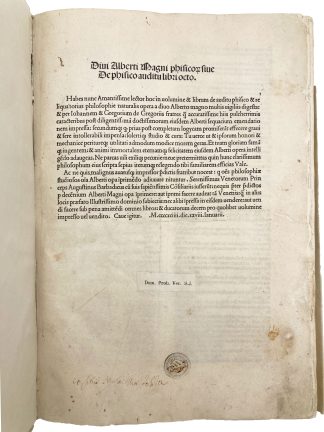ALBERTUS MAGNUS.
NATURAL SCIENCES, PHILOSOPHY AND LOGIC
[Physica].
Venice, Johannes de Forlivio, 31 Jan 1494/5.£3,650.00
Folio. ff. [4], 124. Gothic letter, double column. Printer’s device to last leaf. Little ink marking to blank of t-p, fore-egde of first few ll. a little frayed, couple of small marginal worm holes or trails, some repaired. A good copy in modern vellum, occasional C17 ms marginal annotations, C19 label ‘Dom.[us] Prob.[ationis] Ver.[cellensis?] SJ’, illegible C18 round ink stamp and C17 ms ‘Ex libris Nicolai (?) de S(?)’ to title.
An interesting incunabular edition of Albertus Magnus’ major Aristotelian commentary on the physical sciences. It was part of a project encompassing the printing of revised eds of Albertus Magnus’ works, overseen by the printers Johannes and Gregorius de Gregoriis, in Venice, as stated in the initial privilege. Albertus Magnus (1200-80) was a German friar, later canonised, responsible for the establishment of the curriculum studiorum of the Dominicans, including the study of Aristotle. He was also conversant in the natural sciences, philosophy and astrology. After his death, several works on the secrets of nature were attributed to him. ‘Physica’ is composed of 8 sections, each subdivided into numerous subsections all listed in the remarkably detailed table of contents. Part I discusses the categories of the natural sciences and the principles of logic in relation to ancient Greek philosophers, the determination of true/false statements, and its application to natural philosophy, contrary principles, the ‘in potentia’/‘in actu’ distinction, etc. Part II focuses on the definition of nature, matter, form, absence of matter, physical qualities, and causes. Part III defines motion, the concept of infinity in physical, philosophical, and mathematical terms. Part IV explains the concepts of ‘locus’, eternity, time and its properties. Part V includes the definition of intelligence, and the kinds of motion. Part VI tackles Zeno’s paradox and divisibility. Part VII provides comparisons of contradictory concepts, e.g., generation and corruption. Part VIII examines the properties of motion in relation to the ‘Motor immobilis’. In the C19, this copy was in the library of the Jesuit seminary of Vercelli, used for the training of novices. The C17 glosses point to a scholarly annotator. A great influence on Thomas Aquinas, Albertus Magnus ‘put within the reach of his contemporaries the whole science of Aristotle, and imbibed no small part of his spirit. He recognized the importance of the study of nature, even of testing it by way of experiment’ (White, p.741).
Goff A300; HC(Add) 519*; Bod-inc A-131A; BMC V 346; BSB-Ink A-163; GW 717. F. White, Physical Signs in Medicine and Surgery (2009).





